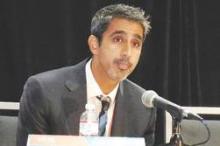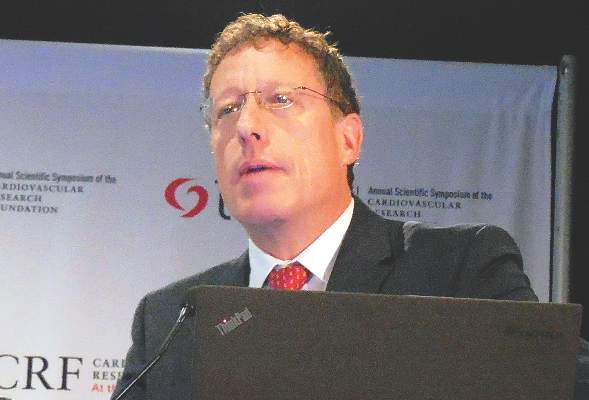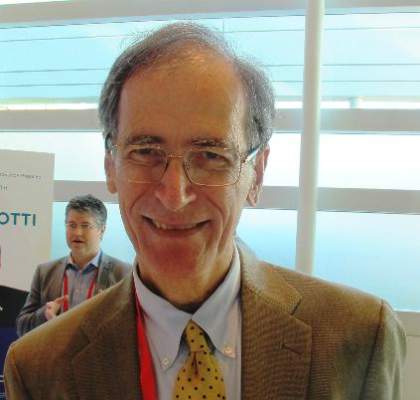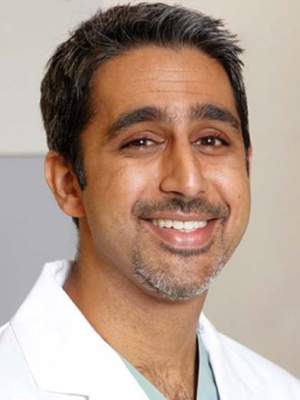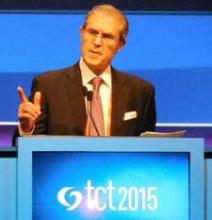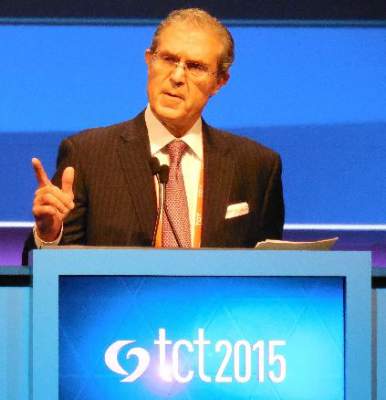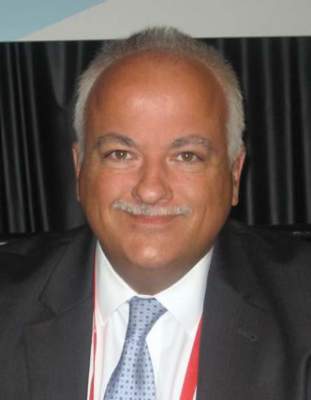User login
Cardiovascular Research Foundation: Transcatheter Cardiovascular Therapeutics (TCT)
TCT: No difference at 2 years between Absorb BVS and XIENCE
SAN FRANCISCO – Two-year clinical outcomes did not differ significantly between patients treated with the Absorb everolimus-eluting bioresorbable vascular scaffold (BVS) and those treated using the Xience everolimus-eluting stent.
In ABSORB II, the first randomized trial to compare the two devices, 11.6% of 335 Absorb BVS patients and 12.8% of 166 Xience patients experienced a patient-oriented composite endpoint that included all death, myocardial infarction, and revascularization, Dr. Bernard Chevalier reported on behalf of the ABSORB II investigators at the Transcatheter Cardiovascular Therapeutics annual meeting.
Furthermore, 7.6% and 4.3% of patients in the Absorb BVS and XIENCE groups, respectively, experienced a major adverse cardiac event, and 7.0% and 3.0%, respectively, experienced a device-oriented composite endpoint (DoCE), or target-lesion failure, including cardiac death, target-vessel MI, and clinically indicated target-lesion revascularization, he said at the meeting, sponsored by the Cardiovascular Research Foundation.
Target-vessel failure, defined as cardiac death, all MI, or clinically indicated target-vessel revascularization, occurred in 8.5% and 6.7% of patients in the groups, respectively, said Dr. Chevalier of Institut Jacques Cartier, Massy, France.
“There was no significant difference on any of these composite endpoints,” he said.
Similarly, no differences were seen with respect to nonhierarchical clinical outcomes at 2 years, he said.
Cardiac death occurred in 1.2% of the Absorb patients and 0.6% of the Xience patients, and noncardiac death occurred in 0.6% and 0% of patient in the groups, respectively; Q-wave MI occurred in 1.5% and 0.6%, and non–Q-wave MI occurred in 4.3% and 1.8%; and definite/probable scaffold thrombosis occurred in 1.54% and 0% of patients in the groups, respectively. The thrombosis events in the Absorb BVS patients included acute/subacute events (occurring at 0-30 days) in 0.60% of patients, late events (occurring at 31-365 days) in 0.30% of patients, and very-late events (at 365-758 days) in 0.62% of patients.
There were no significant differences between groups in postprocedure usage of antiplatelet medications, either for aspirin alone or dual-antiplatelet therapy.
While the findings suggest noninferiority of the Absorb BVS, it is important to keep in mind the limitations of ABSORB II, including the fact that the study was not powered for clinical endpoints, and the 2-year analysis represented a nonprespecified interim analysis, Dr. Chevalier said, noting that the primary endpoint is a 3-year measure of vasomotion.
Furthermore, the investigators’ long experience with Xience, as compared with Absorb BVS, might have affected the results, he noted.
Regarding the persistent numerically, though not statistically significant, worse outcomes for the Absorb BVS vs. the Xience stent on several measures in the ABSORB trials, Dr. Chevalier noted that it remains too early to draw conclusions about potential long-term outcomes. He, along with discussants Dr. Pascal Vranckx of Hartcentrum Hasselt, Belgium, and Dr. Marie-Claude Morice of Institut Hospitalier Jacques Cartier, Massy, stressed that the continued findings of noninferiority of the Absorb device are encouraging, and that at least 3- to 5-year outcomes are needed.
“What’s important, winning the battle or winning the war?” Dr. Vranckx said, stressing that the shorter-term data showing noninferiority don’t provide a clear picture of the end results, but do offer reassurance that the Absorb BVS could ultimately provide an improved alternative to permanent metal stents.
Dr. Daniel I. Simon of University Hospitals Case Medical Center, Cleveland, agreed that the focus should be on the device-related finding.
“The DoCE is what we need to focus on. If the DoCE over time doesn’t narrow down, then potentially there’s an issue. But I think right now we need more people at 24 months, and we have more than twice the number [of patients] in ABSORB III, so I think we have to stay tuned,” he said.
The results of ABSORB III, showing the Absorb scaffold’s noninferiority to the Xience stent at 1 year, were also presented at TCT, and published online (N Engl J Med. 2015 Oct 12;doi: 10.1056NEJMoa1509038).
Dr. Chevalier is a consultant for Abbott Vascular, which sponsored the ABSORB II trial.
SAN FRANCISCO – Two-year clinical outcomes did not differ significantly between patients treated with the Absorb everolimus-eluting bioresorbable vascular scaffold (BVS) and those treated using the Xience everolimus-eluting stent.
In ABSORB II, the first randomized trial to compare the two devices, 11.6% of 335 Absorb BVS patients and 12.8% of 166 Xience patients experienced a patient-oriented composite endpoint that included all death, myocardial infarction, and revascularization, Dr. Bernard Chevalier reported on behalf of the ABSORB II investigators at the Transcatheter Cardiovascular Therapeutics annual meeting.
Furthermore, 7.6% and 4.3% of patients in the Absorb BVS and XIENCE groups, respectively, experienced a major adverse cardiac event, and 7.0% and 3.0%, respectively, experienced a device-oriented composite endpoint (DoCE), or target-lesion failure, including cardiac death, target-vessel MI, and clinically indicated target-lesion revascularization, he said at the meeting, sponsored by the Cardiovascular Research Foundation.
Target-vessel failure, defined as cardiac death, all MI, or clinically indicated target-vessel revascularization, occurred in 8.5% and 6.7% of patients in the groups, respectively, said Dr. Chevalier of Institut Jacques Cartier, Massy, France.
“There was no significant difference on any of these composite endpoints,” he said.
Similarly, no differences were seen with respect to nonhierarchical clinical outcomes at 2 years, he said.
Cardiac death occurred in 1.2% of the Absorb patients and 0.6% of the Xience patients, and noncardiac death occurred in 0.6% and 0% of patient in the groups, respectively; Q-wave MI occurred in 1.5% and 0.6%, and non–Q-wave MI occurred in 4.3% and 1.8%; and definite/probable scaffold thrombosis occurred in 1.54% and 0% of patients in the groups, respectively. The thrombosis events in the Absorb BVS patients included acute/subacute events (occurring at 0-30 days) in 0.60% of patients, late events (occurring at 31-365 days) in 0.30% of patients, and very-late events (at 365-758 days) in 0.62% of patients.
There were no significant differences between groups in postprocedure usage of antiplatelet medications, either for aspirin alone or dual-antiplatelet therapy.
While the findings suggest noninferiority of the Absorb BVS, it is important to keep in mind the limitations of ABSORB II, including the fact that the study was not powered for clinical endpoints, and the 2-year analysis represented a nonprespecified interim analysis, Dr. Chevalier said, noting that the primary endpoint is a 3-year measure of vasomotion.
Furthermore, the investigators’ long experience with Xience, as compared with Absorb BVS, might have affected the results, he noted.
Regarding the persistent numerically, though not statistically significant, worse outcomes for the Absorb BVS vs. the Xience stent on several measures in the ABSORB trials, Dr. Chevalier noted that it remains too early to draw conclusions about potential long-term outcomes. He, along with discussants Dr. Pascal Vranckx of Hartcentrum Hasselt, Belgium, and Dr. Marie-Claude Morice of Institut Hospitalier Jacques Cartier, Massy, stressed that the continued findings of noninferiority of the Absorb device are encouraging, and that at least 3- to 5-year outcomes are needed.
“What’s important, winning the battle or winning the war?” Dr. Vranckx said, stressing that the shorter-term data showing noninferiority don’t provide a clear picture of the end results, but do offer reassurance that the Absorb BVS could ultimately provide an improved alternative to permanent metal stents.
Dr. Daniel I. Simon of University Hospitals Case Medical Center, Cleveland, agreed that the focus should be on the device-related finding.
“The DoCE is what we need to focus on. If the DoCE over time doesn’t narrow down, then potentially there’s an issue. But I think right now we need more people at 24 months, and we have more than twice the number [of patients] in ABSORB III, so I think we have to stay tuned,” he said.
The results of ABSORB III, showing the Absorb scaffold’s noninferiority to the Xience stent at 1 year, were also presented at TCT, and published online (N Engl J Med. 2015 Oct 12;doi: 10.1056NEJMoa1509038).
Dr. Chevalier is a consultant for Abbott Vascular, which sponsored the ABSORB II trial.
SAN FRANCISCO – Two-year clinical outcomes did not differ significantly between patients treated with the Absorb everolimus-eluting bioresorbable vascular scaffold (BVS) and those treated using the Xience everolimus-eluting stent.
In ABSORB II, the first randomized trial to compare the two devices, 11.6% of 335 Absorb BVS patients and 12.8% of 166 Xience patients experienced a patient-oriented composite endpoint that included all death, myocardial infarction, and revascularization, Dr. Bernard Chevalier reported on behalf of the ABSORB II investigators at the Transcatheter Cardiovascular Therapeutics annual meeting.
Furthermore, 7.6% and 4.3% of patients in the Absorb BVS and XIENCE groups, respectively, experienced a major adverse cardiac event, and 7.0% and 3.0%, respectively, experienced a device-oriented composite endpoint (DoCE), or target-lesion failure, including cardiac death, target-vessel MI, and clinically indicated target-lesion revascularization, he said at the meeting, sponsored by the Cardiovascular Research Foundation.
Target-vessel failure, defined as cardiac death, all MI, or clinically indicated target-vessel revascularization, occurred in 8.5% and 6.7% of patients in the groups, respectively, said Dr. Chevalier of Institut Jacques Cartier, Massy, France.
“There was no significant difference on any of these composite endpoints,” he said.
Similarly, no differences were seen with respect to nonhierarchical clinical outcomes at 2 years, he said.
Cardiac death occurred in 1.2% of the Absorb patients and 0.6% of the Xience patients, and noncardiac death occurred in 0.6% and 0% of patient in the groups, respectively; Q-wave MI occurred in 1.5% and 0.6%, and non–Q-wave MI occurred in 4.3% and 1.8%; and definite/probable scaffold thrombosis occurred in 1.54% and 0% of patients in the groups, respectively. The thrombosis events in the Absorb BVS patients included acute/subacute events (occurring at 0-30 days) in 0.60% of patients, late events (occurring at 31-365 days) in 0.30% of patients, and very-late events (at 365-758 days) in 0.62% of patients.
There were no significant differences between groups in postprocedure usage of antiplatelet medications, either for aspirin alone or dual-antiplatelet therapy.
While the findings suggest noninferiority of the Absorb BVS, it is important to keep in mind the limitations of ABSORB II, including the fact that the study was not powered for clinical endpoints, and the 2-year analysis represented a nonprespecified interim analysis, Dr. Chevalier said, noting that the primary endpoint is a 3-year measure of vasomotion.
Furthermore, the investigators’ long experience with Xience, as compared with Absorb BVS, might have affected the results, he noted.
Regarding the persistent numerically, though not statistically significant, worse outcomes for the Absorb BVS vs. the Xience stent on several measures in the ABSORB trials, Dr. Chevalier noted that it remains too early to draw conclusions about potential long-term outcomes. He, along with discussants Dr. Pascal Vranckx of Hartcentrum Hasselt, Belgium, and Dr. Marie-Claude Morice of Institut Hospitalier Jacques Cartier, Massy, stressed that the continued findings of noninferiority of the Absorb device are encouraging, and that at least 3- to 5-year outcomes are needed.
“What’s important, winning the battle or winning the war?” Dr. Vranckx said, stressing that the shorter-term data showing noninferiority don’t provide a clear picture of the end results, but do offer reassurance that the Absorb BVS could ultimately provide an improved alternative to permanent metal stents.
Dr. Daniel I. Simon of University Hospitals Case Medical Center, Cleveland, agreed that the focus should be on the device-related finding.
“The DoCE is what we need to focus on. If the DoCE over time doesn’t narrow down, then potentially there’s an issue. But I think right now we need more people at 24 months, and we have more than twice the number [of patients] in ABSORB III, so I think we have to stay tuned,” he said.
The results of ABSORB III, showing the Absorb scaffold’s noninferiority to the Xience stent at 1 year, were also presented at TCT, and published online (N Engl J Med. 2015 Oct 12;doi: 10.1056NEJMoa1509038).
Dr. Chevalier is a consultant for Abbott Vascular, which sponsored the ABSORB II trial.
AT TCT 2015
Key clinical point: Two-year clinical outcomes did not differ significantly between patients treated with the Absorb everolimus-eluting bioresorbable vascular scaffold (BVS) and those treated using the Xience everolimus-eluting stent in the ABSORB II trial.
Major finding: 7.6% and 4.3% of patients in the Absorb BVS and Xience groups, respectively, experienced a major adverse cardiac event, and 7.0% and 3.0%, respectively, experienced a device-oriented composite endpoint.
Data source: The randomized ABSORB II trial in 501 patients.
Disclosures: ABSORB II was sponsored by Abbott Vascular. Dr. Chevalier is a consultant for Abbott Vascular.
TCT: Ranolazine fails to block angina after incomplete revascularization
SAN FRANCISCO – The antianginal drug ranolazine proved safe but completely ineffective at heading off new, severe anginal episodes when used prophylactically in patients who had recently undergone an incomplete revascularization in a prospective trial with more than 2,600 randomized patients.
While the trial failed to identify a new treatment to help these patients, it succeeded in better defining and documenting an at-risk population that could use a new, effective treatment of some kind: patients who have recently undergone incomplete revascularization.
The RIVER-PCI (Ranolazine for Incomplete Vessel Revascularization Post-Percutaneous Coronary Intervention) trial prospectively followed a large group of these patients with just one other qualification: They had to have also experienced at least two anginal episodes during the prior 1-12 months (angina within 30 days of the PCI didn’t count). The study results showed that during an average 1.8 years of follow-up, these patients had a 27% rate of ischemic, anginal episodes severe enough to push them to either hospitalization or another round of revascularization, Dr. Giora Weisz reported at the Transcatheter Cardiovascular Therapeutics annual meeting.
“This event rate is very high. I want to better treat and do something more for these patients” with incomplete revascularization, “So we still need to look for an answer, to look for other options that might improve their outcomes,” said Dr. Weisz, professor and director of cardiology at the Jerusalem Heart Center of Shaare Zedek Medical Center.
Incomplete revascularization – defined in the study as coronary stenoses visible on an angiogram that block at least 50% of a coronary artery that is at least 2 mm in diameter – occurs quite often, Dr. Weisz noted. These significant stenoses exist in roughly half the patients who undergo PCI and in some instances in as many as 80%. These lesions usually go untreated because they seem clinically unimportant at the time of the index procedure, he explained.
“We need to better understand why the prognosis is so bad” in incompletely revascularized patients. “We need to better understand which lesions are the ones that produce poor outcomes and how we can better treat them both pharmacologically and with interventions,” commented Dr. Stefan James, a professor of cardiology at Uppsala (Sweden) University.
The findings also highlighted the limitations of ranolazine (Ranexa) as a treatment for angina and cardiac ischemia, although Dr. Weisz and others remained convinced that it is an effective drug for reducing angina in other situations, specifically patients with recurring episodes of severe angina.
Ranolazine “did not prevent ischemia, but it remains useful for patients with refractory angina; that is a separate indication,” commented Dr. Sanjit S. Jolly of McMaster University, Hamilton, Ont.
Dr. Weisz speculated that one explanation for ranolazine’s lack of efficacy is that the drug doesn’t prevent ischemia and angina directly but rather interrupts the self-exacerbating cycle of angina. The ischemia that produces angina activates “late sodium” channels in myocardial cells, which boosts intracellular calcium levels and increases oxygen demand in cells while also dropping intracellular oxygen supply, thereby triggering further worsening of the ischemia, he explained. “Ischemia aggravates itself, and ranolazine prevents this by blocking the late sodium channels,” but clearly this effect did not prevent new anginal episodes in patients who experienced incomplete revascularization, he said in an interview.
Dr. Weisz and his associates ran RIVER-PCI during November 2011–May 2013 at 245 sites in 15 countries. They randomized and followed 1,317 patients who received 1,000 mg ranolazine twice daily and 1,287 placebo patients. All patients also received all the other medications appropriate for post-PCI patients, including aspirin and another antiplatelet drug, a statin, a beta-blocker, renin-angiotensin-aldosterone system blocking drugs, as well as other blood pressure lowering and vasodilating medications.
During an average follow-up of 1.8 years, patients in the ranolazine arm had a 26% incidence of ischemia-driven hospitalization of revascularization, and patients in the control arm had a 28% rate, a between-group difference that was not statistically significant. Ranolazine treatment had no significant benefit over placebo for any secondary efficacy measure, but it was also safe and generally well tolerated. About 40% of patients in the ranolazine arm and 36% in the placebo arm discontinued their study treatment during the course of follow-up. Concurrent with Dr. Weisz’s report the results also appeared in an article published online (Lancet 2015 Oct 13;doi: 10.1016/S0140-6736[15]00459-6).
During his report of the findings, Dr. Weisz defended the endpoint used in the study, ischemia-driven hospitalization or revascularization, which he conceded could be considered a “soft” endpoint.
“We had a very strict definition of these events, and every episode was reviewed by an independent committee that judged whether or not to include the event. Every patient with an ischemia-driven event had to show characteristic symptoms and objective evidence of ischemia such as an ECG change or elevated enzymes. We tried to approach judging patient symptoms as scientifically as possible,” he said.
On Twitter @mitchelzoler
The adjunctive treatment of patients who undergo incomplete revascularization is a real unmet need. The results from the RIVER-PCI trial showed that about 27% of patients who undergo an incomplete revascularization with percutaneous coronary intervention have a major ischemia-driven event within the next 2 years. In RIVER-PCI, we were unable to prevent these events by giving patients the anti-ischemia drug ranolazine.
In the study, the rates of new MIs and cardiovascular mortality were relatively low. It was recurrent ischemic events that drove the outcome we saw. If nothing else, this study has opened a new avenue for research into this high-risk group of patients.
 |
| Mitchel L. Zoler/Frontline Medical News Dr. Gregg W. Stone |
As interventional cardiologists, we don’t usually think about the coronary disease that we leave behind following a revascularization procedure. Patients who undergo incomplete revascularization may avoid having an excess of future MIs or death, but they still experience a lot of angina, which leads to rehospitalizations and new procedures. I think we could improve the quality of life for our patients if we can come up with new ways to improve revascularization procedures and better approaches to preventing ischemia and angina following these procedures.
Dr. Gregg W. Stone was chairman of the RIVER-PCI trial and is professor and director of cardiovascular research and education at the Center for Interventional Vascular Therapy at Columbia University in New York. He has been a consultant to nine companies but has no relationship with Gilead Sciences and the Menarini Group, the two companies that sponsored the trial and that market ranolazine. He made these comments during the session that discussed the RIVER-PCI results.
The adjunctive treatment of patients who undergo incomplete revascularization is a real unmet need. The results from the RIVER-PCI trial showed that about 27% of patients who undergo an incomplete revascularization with percutaneous coronary intervention have a major ischemia-driven event within the next 2 years. In RIVER-PCI, we were unable to prevent these events by giving patients the anti-ischemia drug ranolazine.
In the study, the rates of new MIs and cardiovascular mortality were relatively low. It was recurrent ischemic events that drove the outcome we saw. If nothing else, this study has opened a new avenue for research into this high-risk group of patients.
 |
| Mitchel L. Zoler/Frontline Medical News Dr. Gregg W. Stone |
As interventional cardiologists, we don’t usually think about the coronary disease that we leave behind following a revascularization procedure. Patients who undergo incomplete revascularization may avoid having an excess of future MIs or death, but they still experience a lot of angina, which leads to rehospitalizations and new procedures. I think we could improve the quality of life for our patients if we can come up with new ways to improve revascularization procedures and better approaches to preventing ischemia and angina following these procedures.
Dr. Gregg W. Stone was chairman of the RIVER-PCI trial and is professor and director of cardiovascular research and education at the Center for Interventional Vascular Therapy at Columbia University in New York. He has been a consultant to nine companies but has no relationship with Gilead Sciences and the Menarini Group, the two companies that sponsored the trial and that market ranolazine. He made these comments during the session that discussed the RIVER-PCI results.
The adjunctive treatment of patients who undergo incomplete revascularization is a real unmet need. The results from the RIVER-PCI trial showed that about 27% of patients who undergo an incomplete revascularization with percutaneous coronary intervention have a major ischemia-driven event within the next 2 years. In RIVER-PCI, we were unable to prevent these events by giving patients the anti-ischemia drug ranolazine.
In the study, the rates of new MIs and cardiovascular mortality were relatively low. It was recurrent ischemic events that drove the outcome we saw. If nothing else, this study has opened a new avenue for research into this high-risk group of patients.
 |
| Mitchel L. Zoler/Frontline Medical News Dr. Gregg W. Stone |
As interventional cardiologists, we don’t usually think about the coronary disease that we leave behind following a revascularization procedure. Patients who undergo incomplete revascularization may avoid having an excess of future MIs or death, but they still experience a lot of angina, which leads to rehospitalizations and new procedures. I think we could improve the quality of life for our patients if we can come up with new ways to improve revascularization procedures and better approaches to preventing ischemia and angina following these procedures.
Dr. Gregg W. Stone was chairman of the RIVER-PCI trial and is professor and director of cardiovascular research and education at the Center for Interventional Vascular Therapy at Columbia University in New York. He has been a consultant to nine companies but has no relationship with Gilead Sciences and the Menarini Group, the two companies that sponsored the trial and that market ranolazine. He made these comments during the session that discussed the RIVER-PCI results.
SAN FRANCISCO – The antianginal drug ranolazine proved safe but completely ineffective at heading off new, severe anginal episodes when used prophylactically in patients who had recently undergone an incomplete revascularization in a prospective trial with more than 2,600 randomized patients.
While the trial failed to identify a new treatment to help these patients, it succeeded in better defining and documenting an at-risk population that could use a new, effective treatment of some kind: patients who have recently undergone incomplete revascularization.
The RIVER-PCI (Ranolazine for Incomplete Vessel Revascularization Post-Percutaneous Coronary Intervention) trial prospectively followed a large group of these patients with just one other qualification: They had to have also experienced at least two anginal episodes during the prior 1-12 months (angina within 30 days of the PCI didn’t count). The study results showed that during an average 1.8 years of follow-up, these patients had a 27% rate of ischemic, anginal episodes severe enough to push them to either hospitalization or another round of revascularization, Dr. Giora Weisz reported at the Transcatheter Cardiovascular Therapeutics annual meeting.
“This event rate is very high. I want to better treat and do something more for these patients” with incomplete revascularization, “So we still need to look for an answer, to look for other options that might improve their outcomes,” said Dr. Weisz, professor and director of cardiology at the Jerusalem Heart Center of Shaare Zedek Medical Center.
Incomplete revascularization – defined in the study as coronary stenoses visible on an angiogram that block at least 50% of a coronary artery that is at least 2 mm in diameter – occurs quite often, Dr. Weisz noted. These significant stenoses exist in roughly half the patients who undergo PCI and in some instances in as many as 80%. These lesions usually go untreated because they seem clinically unimportant at the time of the index procedure, he explained.
“We need to better understand why the prognosis is so bad” in incompletely revascularized patients. “We need to better understand which lesions are the ones that produce poor outcomes and how we can better treat them both pharmacologically and with interventions,” commented Dr. Stefan James, a professor of cardiology at Uppsala (Sweden) University.
The findings also highlighted the limitations of ranolazine (Ranexa) as a treatment for angina and cardiac ischemia, although Dr. Weisz and others remained convinced that it is an effective drug for reducing angina in other situations, specifically patients with recurring episodes of severe angina.
Ranolazine “did not prevent ischemia, but it remains useful for patients with refractory angina; that is a separate indication,” commented Dr. Sanjit S. Jolly of McMaster University, Hamilton, Ont.
Dr. Weisz speculated that one explanation for ranolazine’s lack of efficacy is that the drug doesn’t prevent ischemia and angina directly but rather interrupts the self-exacerbating cycle of angina. The ischemia that produces angina activates “late sodium” channels in myocardial cells, which boosts intracellular calcium levels and increases oxygen demand in cells while also dropping intracellular oxygen supply, thereby triggering further worsening of the ischemia, he explained. “Ischemia aggravates itself, and ranolazine prevents this by blocking the late sodium channels,” but clearly this effect did not prevent new anginal episodes in patients who experienced incomplete revascularization, he said in an interview.
Dr. Weisz and his associates ran RIVER-PCI during November 2011–May 2013 at 245 sites in 15 countries. They randomized and followed 1,317 patients who received 1,000 mg ranolazine twice daily and 1,287 placebo patients. All patients also received all the other medications appropriate for post-PCI patients, including aspirin and another antiplatelet drug, a statin, a beta-blocker, renin-angiotensin-aldosterone system blocking drugs, as well as other blood pressure lowering and vasodilating medications.
During an average follow-up of 1.8 years, patients in the ranolazine arm had a 26% incidence of ischemia-driven hospitalization of revascularization, and patients in the control arm had a 28% rate, a between-group difference that was not statistically significant. Ranolazine treatment had no significant benefit over placebo for any secondary efficacy measure, but it was also safe and generally well tolerated. About 40% of patients in the ranolazine arm and 36% in the placebo arm discontinued their study treatment during the course of follow-up. Concurrent with Dr. Weisz’s report the results also appeared in an article published online (Lancet 2015 Oct 13;doi: 10.1016/S0140-6736[15]00459-6).
During his report of the findings, Dr. Weisz defended the endpoint used in the study, ischemia-driven hospitalization or revascularization, which he conceded could be considered a “soft” endpoint.
“We had a very strict definition of these events, and every episode was reviewed by an independent committee that judged whether or not to include the event. Every patient with an ischemia-driven event had to show characteristic symptoms and objective evidence of ischemia such as an ECG change or elevated enzymes. We tried to approach judging patient symptoms as scientifically as possible,” he said.
On Twitter @mitchelzoler
SAN FRANCISCO – The antianginal drug ranolazine proved safe but completely ineffective at heading off new, severe anginal episodes when used prophylactically in patients who had recently undergone an incomplete revascularization in a prospective trial with more than 2,600 randomized patients.
While the trial failed to identify a new treatment to help these patients, it succeeded in better defining and documenting an at-risk population that could use a new, effective treatment of some kind: patients who have recently undergone incomplete revascularization.
The RIVER-PCI (Ranolazine for Incomplete Vessel Revascularization Post-Percutaneous Coronary Intervention) trial prospectively followed a large group of these patients with just one other qualification: They had to have also experienced at least two anginal episodes during the prior 1-12 months (angina within 30 days of the PCI didn’t count). The study results showed that during an average 1.8 years of follow-up, these patients had a 27% rate of ischemic, anginal episodes severe enough to push them to either hospitalization or another round of revascularization, Dr. Giora Weisz reported at the Transcatheter Cardiovascular Therapeutics annual meeting.
“This event rate is very high. I want to better treat and do something more for these patients” with incomplete revascularization, “So we still need to look for an answer, to look for other options that might improve their outcomes,” said Dr. Weisz, professor and director of cardiology at the Jerusalem Heart Center of Shaare Zedek Medical Center.
Incomplete revascularization – defined in the study as coronary stenoses visible on an angiogram that block at least 50% of a coronary artery that is at least 2 mm in diameter – occurs quite often, Dr. Weisz noted. These significant stenoses exist in roughly half the patients who undergo PCI and in some instances in as many as 80%. These lesions usually go untreated because they seem clinically unimportant at the time of the index procedure, he explained.
“We need to better understand why the prognosis is so bad” in incompletely revascularized patients. “We need to better understand which lesions are the ones that produce poor outcomes and how we can better treat them both pharmacologically and with interventions,” commented Dr. Stefan James, a professor of cardiology at Uppsala (Sweden) University.
The findings also highlighted the limitations of ranolazine (Ranexa) as a treatment for angina and cardiac ischemia, although Dr. Weisz and others remained convinced that it is an effective drug for reducing angina in other situations, specifically patients with recurring episodes of severe angina.
Ranolazine “did not prevent ischemia, but it remains useful for patients with refractory angina; that is a separate indication,” commented Dr. Sanjit S. Jolly of McMaster University, Hamilton, Ont.
Dr. Weisz speculated that one explanation for ranolazine’s lack of efficacy is that the drug doesn’t prevent ischemia and angina directly but rather interrupts the self-exacerbating cycle of angina. The ischemia that produces angina activates “late sodium” channels in myocardial cells, which boosts intracellular calcium levels and increases oxygen demand in cells while also dropping intracellular oxygen supply, thereby triggering further worsening of the ischemia, he explained. “Ischemia aggravates itself, and ranolazine prevents this by blocking the late sodium channels,” but clearly this effect did not prevent new anginal episodes in patients who experienced incomplete revascularization, he said in an interview.
Dr. Weisz and his associates ran RIVER-PCI during November 2011–May 2013 at 245 sites in 15 countries. They randomized and followed 1,317 patients who received 1,000 mg ranolazine twice daily and 1,287 placebo patients. All patients also received all the other medications appropriate for post-PCI patients, including aspirin and another antiplatelet drug, a statin, a beta-blocker, renin-angiotensin-aldosterone system blocking drugs, as well as other blood pressure lowering and vasodilating medications.
During an average follow-up of 1.8 years, patients in the ranolazine arm had a 26% incidence of ischemia-driven hospitalization of revascularization, and patients in the control arm had a 28% rate, a between-group difference that was not statistically significant. Ranolazine treatment had no significant benefit over placebo for any secondary efficacy measure, but it was also safe and generally well tolerated. About 40% of patients in the ranolazine arm and 36% in the placebo arm discontinued their study treatment during the course of follow-up. Concurrent with Dr. Weisz’s report the results also appeared in an article published online (Lancet 2015 Oct 13;doi: 10.1016/S0140-6736[15]00459-6).
During his report of the findings, Dr. Weisz defended the endpoint used in the study, ischemia-driven hospitalization or revascularization, which he conceded could be considered a “soft” endpoint.
“We had a very strict definition of these events, and every episode was reviewed by an independent committee that judged whether or not to include the event. Every patient with an ischemia-driven event had to show characteristic symptoms and objective evidence of ischemia such as an ECG change or elevated enzymes. We tried to approach judging patient symptoms as scientifically as possible,” he said.
On Twitter @mitchelzoler
AT TCT 2015
Key clinical point: Prophylactic ranolazine failed to stop major episodes of angina in patients who had undergone incomplete coronary revascularization.
Major finding: Ischemia-driven hospitalizations or revascularizations occurred in 26% of patients on ranolazine and 28% of patients on placebo.
Data source: RIVER-PCI, a prospective, multicenter, randomized trial with 2,604 patients treated and followed for an average of 1.8 years.
Disclosures: RIVER-PCI was sponsored by Gilead Sciences and the Menarini Group, the companies that market ranolazine (Ranexa). Dr. Weisz said that he had no relevant disclosures. Dr. James has received honoraria from AstraZeneca, the Medicines Company, and Sanofi-Aventis. Dr. Jolly had no relevant disclosures.
TCT: FFR-CT improved costs, quality of life in PLATFORM trial
SAN FRANCISCO – Estimating fractional flow reserve with computed tomography appears to reduce resource use and costs when compared with invasive coronary angiography in stable patients with possible symptoms of coronary disease, according to a substudy of the prospective, multicenter PLATFORM trial.
Fractional flow reserve estimated by CT (FFR-CT) was also associated with greater improvement in quality of life measures during the 90-day study period, when compared with usual noninvasive testing, Dr. Mark A. Hlatky of Stanford (Calif.) University reported at the Transcatheter Cardiovascular Therapeutics annual meeting.
The PLATFORM trial and substudy data are “game changers,” according to the discussant, Dr. Bernard de Bruyne of Cardiovascular Center Aalst, Belgium, who predicted that if the findings are confirmed in other studies, “this kind of approach will probably largely replace the presently available noninvasive approaches and noninvasive stress testing.”
To assess the effect of using FFR-CT rather than usual care on cost and quality of life, patients with stable symptoms, intermediate probability of CAD (the pretest CAD probability was 49%), and no established CAD diagnosis were enrolled into one of two strata based on whether invasive or noninvasive diagnostic testing was planned. Among 193 patients in the planned invasive testing group who underwent FFR-CT, costs were reduced by 32%, compared with 187 patients in the group who received usual care ($7,343 vs. $10,734). The difference was highly statistically significant.
Among 104 patients in the planned noninvasive testing group who underwent FFR-CT, costs did not differ significantly, compared with 100 in that group who received usual care ($2,679 vs. $2,137), Dr. Hlatky reported at the meeting, which was sponsored by the Cardiovascular Research Foundation.
These findings persisted after propensity score matching, he noted.
Furthermore, scores on each of three quality of life measures improved in the overall study population, and scores in the noninvasive stratum improved more with FFR-CT than with usual care. For example, Seattle Angina Questionnaire scores were 19.5 vs. 11.4, EuroQOL scores were 0.08 vs. 0.03, and visual analog scale scores were 4.1 vs. 2.3 in the groups, respectively. The improvements in the invasive cohort were similar with FFR-CT and usual care, Dr. Hlatky noted.
The findings, published simultaneously online (J Am Coll Cardiol. 2015. doi:10.1016/j.jacc.2015.09.051), suggest that the combination of anatomic and functional data provided by an FFR-CT–guided testing strategy may lead to more selective use of invasive procedures than relying solely on the anatomic data provided by invasive coronary angiography, Dr. Hlatky reported.
He explained that FFR, which assesses the functional significance of individual coronary lesions, can be estimated noninvasively from standardly acquired CT data based on computational fluid dynamics. FFR-CT was recently approved for clinical use by the Food and Drug Administration and the European Medicines Agency based on its diagnostic accuracy, he said.
The clinical effectiveness of the strategy was demonstrated in the PLATFORM trial which showed a reduction in the rate of invasive angiography without obstructive coronary artery disease from 73% to 12% with the use of FFR-CT. The current findings further demonstrate that the approach improves quality of life outcomes.
Though limited by the use of a consecutive observational design, as opposed to a randomized trial design, the large effect sizes suggest that findings would be similar in a randomized study, Dr. Hlatky said.
“I don’t think this is by chance. The plausibility of it has been explained,” he said, adding that while most people are happy with a normal CT angiography because of the high sensitivity, estimated FFR using the CT technique can be helpful in the setting of uncertainty.
“If you see something and you’re not sure if it’s significant, and if the estimated FFR from this technique is normal, that’s extremely reassuring that it’s just something you’re seeing but it’s not necessarily obstructing flow,” he said.
He added that “this would be best tested by doing a real, true, randomized study,” but said he considers the findings to be “quite interesting and completely in line with the clinical results.”
The technique is “entering progressively into practice in Europe,” said Dr. de Bruyne, who is a PLATFORM coinvestigator. “It is already used in clinical practice. You get the anatomy and physiology at the same time and same place. It is a really important paradigm change,” he said.
Dr. Hlatky and Dr. de Bruyne reported receiving research grants from HeartFlow, which supported the study.
SAN FRANCISCO – Estimating fractional flow reserve with computed tomography appears to reduce resource use and costs when compared with invasive coronary angiography in stable patients with possible symptoms of coronary disease, according to a substudy of the prospective, multicenter PLATFORM trial.
Fractional flow reserve estimated by CT (FFR-CT) was also associated with greater improvement in quality of life measures during the 90-day study period, when compared with usual noninvasive testing, Dr. Mark A. Hlatky of Stanford (Calif.) University reported at the Transcatheter Cardiovascular Therapeutics annual meeting.
The PLATFORM trial and substudy data are “game changers,” according to the discussant, Dr. Bernard de Bruyne of Cardiovascular Center Aalst, Belgium, who predicted that if the findings are confirmed in other studies, “this kind of approach will probably largely replace the presently available noninvasive approaches and noninvasive stress testing.”
To assess the effect of using FFR-CT rather than usual care on cost and quality of life, patients with stable symptoms, intermediate probability of CAD (the pretest CAD probability was 49%), and no established CAD diagnosis were enrolled into one of two strata based on whether invasive or noninvasive diagnostic testing was planned. Among 193 patients in the planned invasive testing group who underwent FFR-CT, costs were reduced by 32%, compared with 187 patients in the group who received usual care ($7,343 vs. $10,734). The difference was highly statistically significant.
Among 104 patients in the planned noninvasive testing group who underwent FFR-CT, costs did not differ significantly, compared with 100 in that group who received usual care ($2,679 vs. $2,137), Dr. Hlatky reported at the meeting, which was sponsored by the Cardiovascular Research Foundation.
These findings persisted after propensity score matching, he noted.
Furthermore, scores on each of three quality of life measures improved in the overall study population, and scores in the noninvasive stratum improved more with FFR-CT than with usual care. For example, Seattle Angina Questionnaire scores were 19.5 vs. 11.4, EuroQOL scores were 0.08 vs. 0.03, and visual analog scale scores were 4.1 vs. 2.3 in the groups, respectively. The improvements in the invasive cohort were similar with FFR-CT and usual care, Dr. Hlatky noted.
The findings, published simultaneously online (J Am Coll Cardiol. 2015. doi:10.1016/j.jacc.2015.09.051), suggest that the combination of anatomic and functional data provided by an FFR-CT–guided testing strategy may lead to more selective use of invasive procedures than relying solely on the anatomic data provided by invasive coronary angiography, Dr. Hlatky reported.
He explained that FFR, which assesses the functional significance of individual coronary lesions, can be estimated noninvasively from standardly acquired CT data based on computational fluid dynamics. FFR-CT was recently approved for clinical use by the Food and Drug Administration and the European Medicines Agency based on its diagnostic accuracy, he said.
The clinical effectiveness of the strategy was demonstrated in the PLATFORM trial which showed a reduction in the rate of invasive angiography without obstructive coronary artery disease from 73% to 12% with the use of FFR-CT. The current findings further demonstrate that the approach improves quality of life outcomes.
Though limited by the use of a consecutive observational design, as opposed to a randomized trial design, the large effect sizes suggest that findings would be similar in a randomized study, Dr. Hlatky said.
“I don’t think this is by chance. The plausibility of it has been explained,” he said, adding that while most people are happy with a normal CT angiography because of the high sensitivity, estimated FFR using the CT technique can be helpful in the setting of uncertainty.
“If you see something and you’re not sure if it’s significant, and if the estimated FFR from this technique is normal, that’s extremely reassuring that it’s just something you’re seeing but it’s not necessarily obstructing flow,” he said.
He added that “this would be best tested by doing a real, true, randomized study,” but said he considers the findings to be “quite interesting and completely in line with the clinical results.”
The technique is “entering progressively into practice in Europe,” said Dr. de Bruyne, who is a PLATFORM coinvestigator. “It is already used in clinical practice. You get the anatomy and physiology at the same time and same place. It is a really important paradigm change,” he said.
Dr. Hlatky and Dr. de Bruyne reported receiving research grants from HeartFlow, which supported the study.
SAN FRANCISCO – Estimating fractional flow reserve with computed tomography appears to reduce resource use and costs when compared with invasive coronary angiography in stable patients with possible symptoms of coronary disease, according to a substudy of the prospective, multicenter PLATFORM trial.
Fractional flow reserve estimated by CT (FFR-CT) was also associated with greater improvement in quality of life measures during the 90-day study period, when compared with usual noninvasive testing, Dr. Mark A. Hlatky of Stanford (Calif.) University reported at the Transcatheter Cardiovascular Therapeutics annual meeting.
The PLATFORM trial and substudy data are “game changers,” according to the discussant, Dr. Bernard de Bruyne of Cardiovascular Center Aalst, Belgium, who predicted that if the findings are confirmed in other studies, “this kind of approach will probably largely replace the presently available noninvasive approaches and noninvasive stress testing.”
To assess the effect of using FFR-CT rather than usual care on cost and quality of life, patients with stable symptoms, intermediate probability of CAD (the pretest CAD probability was 49%), and no established CAD diagnosis were enrolled into one of two strata based on whether invasive or noninvasive diagnostic testing was planned. Among 193 patients in the planned invasive testing group who underwent FFR-CT, costs were reduced by 32%, compared with 187 patients in the group who received usual care ($7,343 vs. $10,734). The difference was highly statistically significant.
Among 104 patients in the planned noninvasive testing group who underwent FFR-CT, costs did not differ significantly, compared with 100 in that group who received usual care ($2,679 vs. $2,137), Dr. Hlatky reported at the meeting, which was sponsored by the Cardiovascular Research Foundation.
These findings persisted after propensity score matching, he noted.
Furthermore, scores on each of three quality of life measures improved in the overall study population, and scores in the noninvasive stratum improved more with FFR-CT than with usual care. For example, Seattle Angina Questionnaire scores were 19.5 vs. 11.4, EuroQOL scores were 0.08 vs. 0.03, and visual analog scale scores were 4.1 vs. 2.3 in the groups, respectively. The improvements in the invasive cohort were similar with FFR-CT and usual care, Dr. Hlatky noted.
The findings, published simultaneously online (J Am Coll Cardiol. 2015. doi:10.1016/j.jacc.2015.09.051), suggest that the combination of anatomic and functional data provided by an FFR-CT–guided testing strategy may lead to more selective use of invasive procedures than relying solely on the anatomic data provided by invasive coronary angiography, Dr. Hlatky reported.
He explained that FFR, which assesses the functional significance of individual coronary lesions, can be estimated noninvasively from standardly acquired CT data based on computational fluid dynamics. FFR-CT was recently approved for clinical use by the Food and Drug Administration and the European Medicines Agency based on its diagnostic accuracy, he said.
The clinical effectiveness of the strategy was demonstrated in the PLATFORM trial which showed a reduction in the rate of invasive angiography without obstructive coronary artery disease from 73% to 12% with the use of FFR-CT. The current findings further demonstrate that the approach improves quality of life outcomes.
Though limited by the use of a consecutive observational design, as opposed to a randomized trial design, the large effect sizes suggest that findings would be similar in a randomized study, Dr. Hlatky said.
“I don’t think this is by chance. The plausibility of it has been explained,” he said, adding that while most people are happy with a normal CT angiography because of the high sensitivity, estimated FFR using the CT technique can be helpful in the setting of uncertainty.
“If you see something and you’re not sure if it’s significant, and if the estimated FFR from this technique is normal, that’s extremely reassuring that it’s just something you’re seeing but it’s not necessarily obstructing flow,” he said.
He added that “this would be best tested by doing a real, true, randomized study,” but said he considers the findings to be “quite interesting and completely in line with the clinical results.”
The technique is “entering progressively into practice in Europe,” said Dr. de Bruyne, who is a PLATFORM coinvestigator. “It is already used in clinical practice. You get the anatomy and physiology at the same time and same place. It is a really important paradigm change,” he said.
Dr. Hlatky and Dr. de Bruyne reported receiving research grants from HeartFlow, which supported the study.
AT TCT 2015
Key clinical point: Estimating fractional flow reserve with computed tomography appears to reduce resource use and costs when compared with invasive coronary angiography in stable patients with possible symptoms of coronary disease.
Major finding: Costs in patients in the planned invasive testing group who underwent FFR-CT were reduced by 32% compared with those who received usual care ($7,347 vs. $10,734).
Data source: A prospective, multicenter substudy of the PLATFORM trial, involving 584 patients.
Disclosures: Dr. Hlatky reported receiving research grants from HeartFlow, which supported the study.
TCT: Routine thrombectomy with PCI raises stroke risk 66% in STEMI patients
Routine manual thrombectomy during percutaneous coronary intervention offers no significant long-term benefit over PCI alone for patients with acute ST-segment–elevation myocardial infarction.
In fact, thrombectomy was associated with a 66% increase in stroke risk in the year following a heart attack, Dr. Sanjit Jolly reported at the Transcatheter Cardiovascular Therapeutics annual meeting.
A 1-year analysis of the TOTAL trial confirmed the study’s recently published 1-month findings: Routine thrombectomy isn’t any better than PCI alone in the clinical outcomes of cardiovascular death, myocardial infarction, cardiogenic shock, or heart failure.
As it was at 1 month, however, stroke at 1 year was significantly more common; it occurred in 60 patients (1.2%) in the thrombectomy group and 36 (0.7%) in the PCI-alone group, for an increase in risk of 66% (P = .015).
The findings were simultaneously published online (Lancet 2015 Oct 13 doi: 10.1016/ S0140-6736[15]00448-1).
“Based on these endpoints, manual thrombectomy can no longer be recommended as a primary strategy in these patients,” Dr. Jolly said at the meeting, which was sponsored by the Cardiovascular Research Foundation.
Despite the unequivocal findings, it’s unclear when clinicians will completely embrace TOTAL’s results, noted Dr. Jolly of McMaster University, Hamilton, Ont.
“Unfortunately, practice has not changed with these findings. It often takes time for new evidence to get translated into the clinic, although some of my colleagues have told me that the results are giving them pause, causing them to use less thrombus aspiration. But interventional cardiologists are very visually driven. If we see something, we want to take it out. So it may take some time for these to be adopted,” he said.
The Thromwbectomy With PCI Versus PCI Alone in Patients With STEMI (TOTAL) trial randomized 10,723 patients to percutaneous coronary intervention with or without routine manual thrombectomy. The primary outcome was a composite of death from cardiovascular causes, recurrent myocardial infarction, cardiogenic shock, or New York Heart Association class IV heart failure within 180 days. The key safety outcome was stroke within 30 days.
The TOTAL results showed no difference in the primary outcome between thrombectomy and PCI patients (6.9% vs. 7%) (N Engl J Med. 2015 Apr 9;372[15]:1389-98).
Rates of cardiovascular death were similar (3% in each group) as were those for a combination of the primary outcome plus stent thrombosis or revascularization (10% in each group). Patients who had a thrombectomy were twice as likely to have a stroke within 30 days, although the absolute numbers were small (0.7% vs. 0.3%; HR, 2.06).
The 1-year follow-up study provided important perspective about the long-term risks and benefits of the two strategies.
There was no difference in the rate of the composite endpoint, which occurred in 7.8% of each group. Cardiovascular death occurred in 3.6% of the thrombectomy group and 3.8% of the PCI-alone group. There were similar rates of recurrent heart attack (2.5% vs. 2.3%), cardiogenic shock (1.9% vs. 2.1%), and class IV heart failure (2.1% vs. 1.9%).
The finding of significantly elevated stroke risk at 30 days was also present at 1 year, occurring in 1.2% of the thrombectomy patients and 0.7% of the PCI-alone patients (HR, 1.66; P = .015). The risk of a combination of stroke or transient ischemic attack was also increased significantly, by 65%, occurring in 1.4% and 0.9%, respectively (HR, 1.65; P = .008).
To further confirm the findings, Dr. Jolly also presented a meta-analysis of all-cause mortality in 20,352 patients involved in 16 studies comparing PCI plus thrombectomy with PCI alone. The meta-analysis also found that routine thrombectomy conferred no mortality benefit over PCI.
It did, however, confirm a 43% increased risk of stroke in PCI plus thrombectomy vs. PCI alone, at 0.9% and 0.6% (P = .03).
TOTAL was funded by the Canadian Institutes of Health Research, the Canadian Network and Centre for Trials Internationally, and Medtronic. Dr. Jolly received grants from Medtronic during the study.
On Twitter @Alz_Gal
Routine manual thrombectomy during percutaneous coronary intervention offers no significant long-term benefit over PCI alone for patients with acute ST-segment–elevation myocardial infarction.
In fact, thrombectomy was associated with a 66% increase in stroke risk in the year following a heart attack, Dr. Sanjit Jolly reported at the Transcatheter Cardiovascular Therapeutics annual meeting.
A 1-year analysis of the TOTAL trial confirmed the study’s recently published 1-month findings: Routine thrombectomy isn’t any better than PCI alone in the clinical outcomes of cardiovascular death, myocardial infarction, cardiogenic shock, or heart failure.
As it was at 1 month, however, stroke at 1 year was significantly more common; it occurred in 60 patients (1.2%) in the thrombectomy group and 36 (0.7%) in the PCI-alone group, for an increase in risk of 66% (P = .015).
The findings were simultaneously published online (Lancet 2015 Oct 13 doi: 10.1016/ S0140-6736[15]00448-1).
“Based on these endpoints, manual thrombectomy can no longer be recommended as a primary strategy in these patients,” Dr. Jolly said at the meeting, which was sponsored by the Cardiovascular Research Foundation.
Despite the unequivocal findings, it’s unclear when clinicians will completely embrace TOTAL’s results, noted Dr. Jolly of McMaster University, Hamilton, Ont.
“Unfortunately, practice has not changed with these findings. It often takes time for new evidence to get translated into the clinic, although some of my colleagues have told me that the results are giving them pause, causing them to use less thrombus aspiration. But interventional cardiologists are very visually driven. If we see something, we want to take it out. So it may take some time for these to be adopted,” he said.
The Thromwbectomy With PCI Versus PCI Alone in Patients With STEMI (TOTAL) trial randomized 10,723 patients to percutaneous coronary intervention with or without routine manual thrombectomy. The primary outcome was a composite of death from cardiovascular causes, recurrent myocardial infarction, cardiogenic shock, or New York Heart Association class IV heart failure within 180 days. The key safety outcome was stroke within 30 days.
The TOTAL results showed no difference in the primary outcome between thrombectomy and PCI patients (6.9% vs. 7%) (N Engl J Med. 2015 Apr 9;372[15]:1389-98).
Rates of cardiovascular death were similar (3% in each group) as were those for a combination of the primary outcome plus stent thrombosis or revascularization (10% in each group). Patients who had a thrombectomy were twice as likely to have a stroke within 30 days, although the absolute numbers were small (0.7% vs. 0.3%; HR, 2.06).
The 1-year follow-up study provided important perspective about the long-term risks and benefits of the two strategies.
There was no difference in the rate of the composite endpoint, which occurred in 7.8% of each group. Cardiovascular death occurred in 3.6% of the thrombectomy group and 3.8% of the PCI-alone group. There were similar rates of recurrent heart attack (2.5% vs. 2.3%), cardiogenic shock (1.9% vs. 2.1%), and class IV heart failure (2.1% vs. 1.9%).
The finding of significantly elevated stroke risk at 30 days was also present at 1 year, occurring in 1.2% of the thrombectomy patients and 0.7% of the PCI-alone patients (HR, 1.66; P = .015). The risk of a combination of stroke or transient ischemic attack was also increased significantly, by 65%, occurring in 1.4% and 0.9%, respectively (HR, 1.65; P = .008).
To further confirm the findings, Dr. Jolly also presented a meta-analysis of all-cause mortality in 20,352 patients involved in 16 studies comparing PCI plus thrombectomy with PCI alone. The meta-analysis also found that routine thrombectomy conferred no mortality benefit over PCI.
It did, however, confirm a 43% increased risk of stroke in PCI plus thrombectomy vs. PCI alone, at 0.9% and 0.6% (P = .03).
TOTAL was funded by the Canadian Institutes of Health Research, the Canadian Network and Centre for Trials Internationally, and Medtronic. Dr. Jolly received grants from Medtronic during the study.
On Twitter @Alz_Gal
Routine manual thrombectomy during percutaneous coronary intervention offers no significant long-term benefit over PCI alone for patients with acute ST-segment–elevation myocardial infarction.
In fact, thrombectomy was associated with a 66% increase in stroke risk in the year following a heart attack, Dr. Sanjit Jolly reported at the Transcatheter Cardiovascular Therapeutics annual meeting.
A 1-year analysis of the TOTAL trial confirmed the study’s recently published 1-month findings: Routine thrombectomy isn’t any better than PCI alone in the clinical outcomes of cardiovascular death, myocardial infarction, cardiogenic shock, or heart failure.
As it was at 1 month, however, stroke at 1 year was significantly more common; it occurred in 60 patients (1.2%) in the thrombectomy group and 36 (0.7%) in the PCI-alone group, for an increase in risk of 66% (P = .015).
The findings were simultaneously published online (Lancet 2015 Oct 13 doi: 10.1016/ S0140-6736[15]00448-1).
“Based on these endpoints, manual thrombectomy can no longer be recommended as a primary strategy in these patients,” Dr. Jolly said at the meeting, which was sponsored by the Cardiovascular Research Foundation.
Despite the unequivocal findings, it’s unclear when clinicians will completely embrace TOTAL’s results, noted Dr. Jolly of McMaster University, Hamilton, Ont.
“Unfortunately, practice has not changed with these findings. It often takes time for new evidence to get translated into the clinic, although some of my colleagues have told me that the results are giving them pause, causing them to use less thrombus aspiration. But interventional cardiologists are very visually driven. If we see something, we want to take it out. So it may take some time for these to be adopted,” he said.
The Thromwbectomy With PCI Versus PCI Alone in Patients With STEMI (TOTAL) trial randomized 10,723 patients to percutaneous coronary intervention with or without routine manual thrombectomy. The primary outcome was a composite of death from cardiovascular causes, recurrent myocardial infarction, cardiogenic shock, or New York Heart Association class IV heart failure within 180 days. The key safety outcome was stroke within 30 days.
The TOTAL results showed no difference in the primary outcome between thrombectomy and PCI patients (6.9% vs. 7%) (N Engl J Med. 2015 Apr 9;372[15]:1389-98).
Rates of cardiovascular death were similar (3% in each group) as were those for a combination of the primary outcome plus stent thrombosis or revascularization (10% in each group). Patients who had a thrombectomy were twice as likely to have a stroke within 30 days, although the absolute numbers were small (0.7% vs. 0.3%; HR, 2.06).
The 1-year follow-up study provided important perspective about the long-term risks and benefits of the two strategies.
There was no difference in the rate of the composite endpoint, which occurred in 7.8% of each group. Cardiovascular death occurred in 3.6% of the thrombectomy group and 3.8% of the PCI-alone group. There were similar rates of recurrent heart attack (2.5% vs. 2.3%), cardiogenic shock (1.9% vs. 2.1%), and class IV heart failure (2.1% vs. 1.9%).
The finding of significantly elevated stroke risk at 30 days was also present at 1 year, occurring in 1.2% of the thrombectomy patients and 0.7% of the PCI-alone patients (HR, 1.66; P = .015). The risk of a combination of stroke or transient ischemic attack was also increased significantly, by 65%, occurring in 1.4% and 0.9%, respectively (HR, 1.65; P = .008).
To further confirm the findings, Dr. Jolly also presented a meta-analysis of all-cause mortality in 20,352 patients involved in 16 studies comparing PCI plus thrombectomy with PCI alone. The meta-analysis also found that routine thrombectomy conferred no mortality benefit over PCI.
It did, however, confirm a 43% increased risk of stroke in PCI plus thrombectomy vs. PCI alone, at 0.9% and 0.6% (P = .03).
TOTAL was funded by the Canadian Institutes of Health Research, the Canadian Network and Centre for Trials Internationally, and Medtronic. Dr. Jolly received grants from Medtronic during the study.
On Twitter @Alz_Gal
AT TCT 2015
Key clinical point: Adding routine thrombectomy to PCI doesn’t improve outcomes; in fact, it increases the risk of stroke by 66% at 1 year.
Major finding: At 1 year, thrombectomy didn’t improve cardiovascular outcomes over PCI alone for patients with STEMI; in fact, it increased the risk of stroke by 66%.
Data source: The TOTAL trial randomizing 10,732 patients with STEMI to either PCI plus manual thrombectomy or PCI alone.
Disclosures: TOTAL was funded by the Canadian Institutes of Health Research, the Canadian Network and Centre for Trials Internationally, and Medtronic. Dr. Jolly received grants from Medtronic during the study.
TCT: Absorb BVS meets pivotal U.S. noninferiority goal
SAN FRANCISCO – The first bioresorbable vascular scaffold to finish a U.S. pivotal trial met its prespecified noninferiority endpoint, compared with the best-available metallic drug-eluting stent, putting the Absorb scaffold in good position to soon reach the U.S. market.
But, as expected, the results from the pivotal ABSORB III randomized controlled trial also left unaddressed the question of whether bioresorbable vascular scaffolds (BVS) actually offer patients any benefit above the best metallic drug-eluting stent comparator. That part won’t be answered for several more years, until results from an expanded, prospective group of 5,000 randomized patients are followed for something like 5 years, study researchers said.
Until then, favoring the Absorb stent over a metallic model will involve “a leap of faith,” admitted Dr. Dean J. Kereiakes, coprincipal investigator of the trial, who reported the ABSORB III results at the Transcatheter Cardiovascular Therapeutics annual meeting.
“There was no expectation that Absorb would be superior at 1 year,” emphasized Dr. Gregg W. Stone, chairman of the trial during discussion of the results. “The thought is that, as the Absorb BVS disappears over several years, then we’ll start to see improved outcomes,” said Dr. Stone, professor and director of cardiovascular research and education at the Center for Interventional Vascular Therapy of Columbia University in New York.
“The best metallic drug-eluting stents have a total lesion failure rate of about 17% after 5 years, with about half due to the device,” commented Dr. Daniel I. Simon, professor and chief of cardiovascular medicine at University Hospitals Case Medical Center in Cleveland. “This is an unmet need to address. We need to do better for patients, and this is a tool to do that,” he said during a press conference at the meeting.
The ABSORB III trial enrolled 2,008 patients with stable or unstable angina undergoing percutaneous coronary intervention at 193 centers in the United States and Australia. Patients’ coronary lesions received treatment with either the Absorb BVS or the Xience V everolimus-eluting cobalt-chromium stent. The primary endpoint was a test for noninferiority by the Absorb BVS for target-lesion failure after 1 year, defined as the combined rate of cardiovascular death, target-vessel MI, or ischemia-driven target-lesion revascularization.
The 1-year rates were 7.8% in 1,312 Absorb recipients who completed the 12-month follow-up and a 6.1% rate in 677 control patients. The upper statistical limit of the 1.7%-between group difference fell within the 4.5% prespecified difference for noninferiority, Dr. Kereiakes reported at the meeting, sponsored by the Cardiovascular Research Foundation. Concurrent with his report the results appeared online (N Engl J Med. 2015 Oct 12;doi: 10.1056NEJMoa1509038).
Although the results met the study’s primary endpoint, the outcomes showed that the Absorb BVS numerically underperformed the comparator metallic stent by several individual efficacy and safety parameters, including target-vessel MI and stent thrombosis, but none of the differences were statistically significant. Dr. Kereiakes dismissed these as “small, insignificant differences for low-frequency events that were underpowered to show differences.” The results also showed no suggestion that the incidence of angina during 1-year follow-up differed between the two treatment arms, indicating that prior evidence for an angina-reducing benefit with BVS treatment that had been seen in smaller studies had been misleading, Dr. Stone acknowledged.
Dr. Kereiakes stressed that the noninferiority outcome occurred in procedures performed by operators who largely used BVS for the first time. Despite that, the procedural success rate with the BVS was similar to that of the metallic stent. Procedures using a BVS averaged 4 minutes longer than did placement of the metallic stent.
One additional analysis presented by Dr. Kereiakes provided an important lesson about the danger of using the Absorb BVS in coronary arteries less than 2.5 mm in diameter. Even though the study protocol specified not treating vessels less than 2.5 mm in diameter, case records showed that 19% of the BVS target vessels had diameters of 2.25 mm or less, noted Dr. Kereiakes, medical director of the Christ Hospital Heart and Vascular Center in Cincinnati. Within this subgroup, the rate of target-lesion failure ran 13% with BVS and 8% with the metallic stent, while in the 80% of vessels that were properly sized, the primary endpoint occurred in 7% and 6% respectively.
“The lesson is clear: This BVS does not perform well in small vessels when operators do not use the correct methodology with aggressive postdilitation,” commented Dr. Martin B. Leon, director of the Center for Interventional Vascular Therapy of Columbia University in New York.
ABSORB III was sponsored by Abbott Vascular, which markets the Absorb BVS. Dr. Kereiakes has been a consultant to Abbott Vascular as well as to HCRI, Boston Scientific, Svelte, Janssen, and Sanofi-Aventis, and he holds equity interest in Ablative Solution. Dr. Stone has received grant support and consultant fees from Abbott Vascular and has been a consultant to 12 other companies and holds equity options in 8t companies. Dr. Simon has received research grants from and has been a consultant to Medtronic and a consultant to Cordis, Merck, and Janssen. Dr. Leon had no relevant disclosures.
On Twitter @mitchelzoler
SAN FRANCISCO – The first bioresorbable vascular scaffold to finish a U.S. pivotal trial met its prespecified noninferiority endpoint, compared with the best-available metallic drug-eluting stent, putting the Absorb scaffold in good position to soon reach the U.S. market.
But, as expected, the results from the pivotal ABSORB III randomized controlled trial also left unaddressed the question of whether bioresorbable vascular scaffolds (BVS) actually offer patients any benefit above the best metallic drug-eluting stent comparator. That part won’t be answered for several more years, until results from an expanded, prospective group of 5,000 randomized patients are followed for something like 5 years, study researchers said.
Until then, favoring the Absorb stent over a metallic model will involve “a leap of faith,” admitted Dr. Dean J. Kereiakes, coprincipal investigator of the trial, who reported the ABSORB III results at the Transcatheter Cardiovascular Therapeutics annual meeting.
“There was no expectation that Absorb would be superior at 1 year,” emphasized Dr. Gregg W. Stone, chairman of the trial during discussion of the results. “The thought is that, as the Absorb BVS disappears over several years, then we’ll start to see improved outcomes,” said Dr. Stone, professor and director of cardiovascular research and education at the Center for Interventional Vascular Therapy of Columbia University in New York.
“The best metallic drug-eluting stents have a total lesion failure rate of about 17% after 5 years, with about half due to the device,” commented Dr. Daniel I. Simon, professor and chief of cardiovascular medicine at University Hospitals Case Medical Center in Cleveland. “This is an unmet need to address. We need to do better for patients, and this is a tool to do that,” he said during a press conference at the meeting.
The ABSORB III trial enrolled 2,008 patients with stable or unstable angina undergoing percutaneous coronary intervention at 193 centers in the United States and Australia. Patients’ coronary lesions received treatment with either the Absorb BVS or the Xience V everolimus-eluting cobalt-chromium stent. The primary endpoint was a test for noninferiority by the Absorb BVS for target-lesion failure after 1 year, defined as the combined rate of cardiovascular death, target-vessel MI, or ischemia-driven target-lesion revascularization.
The 1-year rates were 7.8% in 1,312 Absorb recipients who completed the 12-month follow-up and a 6.1% rate in 677 control patients. The upper statistical limit of the 1.7%-between group difference fell within the 4.5% prespecified difference for noninferiority, Dr. Kereiakes reported at the meeting, sponsored by the Cardiovascular Research Foundation. Concurrent with his report the results appeared online (N Engl J Med. 2015 Oct 12;doi: 10.1056NEJMoa1509038).
Although the results met the study’s primary endpoint, the outcomes showed that the Absorb BVS numerically underperformed the comparator metallic stent by several individual efficacy and safety parameters, including target-vessel MI and stent thrombosis, but none of the differences were statistically significant. Dr. Kereiakes dismissed these as “small, insignificant differences for low-frequency events that were underpowered to show differences.” The results also showed no suggestion that the incidence of angina during 1-year follow-up differed between the two treatment arms, indicating that prior evidence for an angina-reducing benefit with BVS treatment that had been seen in smaller studies had been misleading, Dr. Stone acknowledged.
Dr. Kereiakes stressed that the noninferiority outcome occurred in procedures performed by operators who largely used BVS for the first time. Despite that, the procedural success rate with the BVS was similar to that of the metallic stent. Procedures using a BVS averaged 4 minutes longer than did placement of the metallic stent.
One additional analysis presented by Dr. Kereiakes provided an important lesson about the danger of using the Absorb BVS in coronary arteries less than 2.5 mm in diameter. Even though the study protocol specified not treating vessels less than 2.5 mm in diameter, case records showed that 19% of the BVS target vessels had diameters of 2.25 mm or less, noted Dr. Kereiakes, medical director of the Christ Hospital Heart and Vascular Center in Cincinnati. Within this subgroup, the rate of target-lesion failure ran 13% with BVS and 8% with the metallic stent, while in the 80% of vessels that were properly sized, the primary endpoint occurred in 7% and 6% respectively.
“The lesson is clear: This BVS does not perform well in small vessels when operators do not use the correct methodology with aggressive postdilitation,” commented Dr. Martin B. Leon, director of the Center for Interventional Vascular Therapy of Columbia University in New York.
ABSORB III was sponsored by Abbott Vascular, which markets the Absorb BVS. Dr. Kereiakes has been a consultant to Abbott Vascular as well as to HCRI, Boston Scientific, Svelte, Janssen, and Sanofi-Aventis, and he holds equity interest in Ablative Solution. Dr. Stone has received grant support and consultant fees from Abbott Vascular and has been a consultant to 12 other companies and holds equity options in 8t companies. Dr. Simon has received research grants from and has been a consultant to Medtronic and a consultant to Cordis, Merck, and Janssen. Dr. Leon had no relevant disclosures.
On Twitter @mitchelzoler
SAN FRANCISCO – The first bioresorbable vascular scaffold to finish a U.S. pivotal trial met its prespecified noninferiority endpoint, compared with the best-available metallic drug-eluting stent, putting the Absorb scaffold in good position to soon reach the U.S. market.
But, as expected, the results from the pivotal ABSORB III randomized controlled trial also left unaddressed the question of whether bioresorbable vascular scaffolds (BVS) actually offer patients any benefit above the best metallic drug-eluting stent comparator. That part won’t be answered for several more years, until results from an expanded, prospective group of 5,000 randomized patients are followed for something like 5 years, study researchers said.
Until then, favoring the Absorb stent over a metallic model will involve “a leap of faith,” admitted Dr. Dean J. Kereiakes, coprincipal investigator of the trial, who reported the ABSORB III results at the Transcatheter Cardiovascular Therapeutics annual meeting.
“There was no expectation that Absorb would be superior at 1 year,” emphasized Dr. Gregg W. Stone, chairman of the trial during discussion of the results. “The thought is that, as the Absorb BVS disappears over several years, then we’ll start to see improved outcomes,” said Dr. Stone, professor and director of cardiovascular research and education at the Center for Interventional Vascular Therapy of Columbia University in New York.
“The best metallic drug-eluting stents have a total lesion failure rate of about 17% after 5 years, with about half due to the device,” commented Dr. Daniel I. Simon, professor and chief of cardiovascular medicine at University Hospitals Case Medical Center in Cleveland. “This is an unmet need to address. We need to do better for patients, and this is a tool to do that,” he said during a press conference at the meeting.
The ABSORB III trial enrolled 2,008 patients with stable or unstable angina undergoing percutaneous coronary intervention at 193 centers in the United States and Australia. Patients’ coronary lesions received treatment with either the Absorb BVS or the Xience V everolimus-eluting cobalt-chromium stent. The primary endpoint was a test for noninferiority by the Absorb BVS for target-lesion failure after 1 year, defined as the combined rate of cardiovascular death, target-vessel MI, or ischemia-driven target-lesion revascularization.
The 1-year rates were 7.8% in 1,312 Absorb recipients who completed the 12-month follow-up and a 6.1% rate in 677 control patients. The upper statistical limit of the 1.7%-between group difference fell within the 4.5% prespecified difference for noninferiority, Dr. Kereiakes reported at the meeting, sponsored by the Cardiovascular Research Foundation. Concurrent with his report the results appeared online (N Engl J Med. 2015 Oct 12;doi: 10.1056NEJMoa1509038).
Although the results met the study’s primary endpoint, the outcomes showed that the Absorb BVS numerically underperformed the comparator metallic stent by several individual efficacy and safety parameters, including target-vessel MI and stent thrombosis, but none of the differences were statistically significant. Dr. Kereiakes dismissed these as “small, insignificant differences for low-frequency events that were underpowered to show differences.” The results also showed no suggestion that the incidence of angina during 1-year follow-up differed between the two treatment arms, indicating that prior evidence for an angina-reducing benefit with BVS treatment that had been seen in smaller studies had been misleading, Dr. Stone acknowledged.
Dr. Kereiakes stressed that the noninferiority outcome occurred in procedures performed by operators who largely used BVS for the first time. Despite that, the procedural success rate with the BVS was similar to that of the metallic stent. Procedures using a BVS averaged 4 minutes longer than did placement of the metallic stent.
One additional analysis presented by Dr. Kereiakes provided an important lesson about the danger of using the Absorb BVS in coronary arteries less than 2.5 mm in diameter. Even though the study protocol specified not treating vessels less than 2.5 mm in diameter, case records showed that 19% of the BVS target vessels had diameters of 2.25 mm or less, noted Dr. Kereiakes, medical director of the Christ Hospital Heart and Vascular Center in Cincinnati. Within this subgroup, the rate of target-lesion failure ran 13% with BVS and 8% with the metallic stent, while in the 80% of vessels that were properly sized, the primary endpoint occurred in 7% and 6% respectively.
“The lesson is clear: This BVS does not perform well in small vessels when operators do not use the correct methodology with aggressive postdilitation,” commented Dr. Martin B. Leon, director of the Center for Interventional Vascular Therapy of Columbia University in New York.
ABSORB III was sponsored by Abbott Vascular, which markets the Absorb BVS. Dr. Kereiakes has been a consultant to Abbott Vascular as well as to HCRI, Boston Scientific, Svelte, Janssen, and Sanofi-Aventis, and he holds equity interest in Ablative Solution. Dr. Stone has received grant support and consultant fees from Abbott Vascular and has been a consultant to 12 other companies and holds equity options in 8t companies. Dr. Simon has received research grants from and has been a consultant to Medtronic and a consultant to Cordis, Merck, and Janssen. Dr. Leon had no relevant disclosures.
On Twitter @mitchelzoler
AT TCT 2015
Key clinical point: The Absorb bioresorbable vascular scaffold met its prespecified noninferiority primary endpoint in its pivotal U.S. trial.
Major finding: Target-lesion failure occurred in 7.8% of Absorb patients and 6.1% of controls on the best metallic drug-eluting stent.
Data source: ABSORB III, a pivotal randomized controlled trial with 2,008 patients run at 193 centers in the United States and Australia.
Disclosures: ABSORB III was sponsored by Abbott Vascular, which markets the Absorb BVS. Dr. Kereiakes has been a consultant to Abbott Vascular as well as to HCRI, Boston Scientific, Svelte, Janssen, and Sanofi-Aventis, and he holds equity interest in Ablative Solution.
TCT: Absorbable metal scaffold performs well in BIOSOLVE II
SAN FRANCISCO – Implantation of the novel DREAMS 2G sirolimus-eluting absorbable metal scaffold in patients with de novo coronary lesions was feasible and had favorable safety and performance outcomes at 6 months in the BIOSOLVE-II trial.
The findings of the prospective, nonrandomized, first-in-human trial suggest that the DREAMS 2G device – made from magnesium alloy with an absorption time of 12 months – could serve as an alternative to absorbable polymeric scaffolds for the treatment of obstructive coronary disease, Dr. Michael Haude of Medical Clinic I, Städtische Kliniken Neuss, Germany, reported at the Transcatheter Cardiovascular Therapeutics annual meeting.
In 120 patients with coronary target lesions who completed the trial and follow-up, the mean in-segment late lumen loss at 6 months – the primary endpoint of the study – was 0.27 mm, and in-scaffold late lumen loss was 0.44 mm. Discernable vasomotion was documented in 80% of a subgroup of 25 patients, he said at the meeting, which was sponsored by the Cardiovascular Research Foundation.
Among patients who underwent additional assessment, intravascular ultrasound showed preservation of the scaffold area (mean of 6.24 mm2 post procedure vs. 6.21 mm2 at 6 months) with a low mean neointimal area (0.08 mm2). No intraluminal mass was detected on optical coherence tomography, he noted.
Four patients (3%) experienced target lesion failure, and one died from cardiac death.
Periprocedural myocardial infarction occurred in one patient, and clinically driven target lesion revascularization was required in two patients (1.7%).
No definite or probable scaffold thrombosis was observed, Dr. Haude said.
Study subjects were enrolled during October 2013–May 2015 at centers in Belgium, Brazil, Denmark, Germany, Singapore, Spain, Switzerland, and the Netherlands. All had stable or unstable angina or documented silent ischemia and no more than two de novo lesions with a reference vessel diameter between 2.2 and 3.7 mm. The results were published online concurrently with Dr. Haude’s presentation (Lancet. 2015 Oct 12. doi:10.1016/S0140-6736[15]00447-X)
The findings demonstrate improved lumen loss with the DREAMS 2G device, compared with precursor devices, he said.
“If we compare this to the data that we have for the previous version, the bare version of the magnesium absorbable scaffold, the in-segment lumen loss was 0.83. That went down by 37% to the version with the paclitaxel elusion at 0.52, and then it decreased again by 48% to 0.27 ... without a single stent thrombosis case,” he said.
Absorbable metal scaffolds offer good radial strength, low acute recoil, and high compliance to the vessel geometry. Also, they can be implanted via a single step inflation, and thus can be implanted in a way similar to that of a permanent metal stent, he noted.
They can also be electropolished, which provides softer, round edges that allow for improved trackability and deliverability, he said, noting that the magnesium alloy stent provides the strength of metal, but also provides a potential long-term benefit with its ability to be absorbed over time.
Though limited by the nonrandomized trial design and lack of direct comparison with other permanent stents or scaffolds, as well as by the inclusion of only patients with straightforward de novo lesions and uncertainty about ideal follow-up time, DREAMS 2G offers a potential alternative to polymeric absorbable scaffolds, which are currently the scaffolds that are commercially available , Dr. Haude said.
BIOSOLVE-II was funded by Biotronik AG. Dr. Haude received study grants and lecture fees from Biotronik, Abbott Vascular, Cardiac dimensions, Medtronic, Volcano, and Lilly, as well as consulting fees/honoraria from Biotronik AG.
SAN FRANCISCO – Implantation of the novel DREAMS 2G sirolimus-eluting absorbable metal scaffold in patients with de novo coronary lesions was feasible and had favorable safety and performance outcomes at 6 months in the BIOSOLVE-II trial.
The findings of the prospective, nonrandomized, first-in-human trial suggest that the DREAMS 2G device – made from magnesium alloy with an absorption time of 12 months – could serve as an alternative to absorbable polymeric scaffolds for the treatment of obstructive coronary disease, Dr. Michael Haude of Medical Clinic I, Städtische Kliniken Neuss, Germany, reported at the Transcatheter Cardiovascular Therapeutics annual meeting.
In 120 patients with coronary target lesions who completed the trial and follow-up, the mean in-segment late lumen loss at 6 months – the primary endpoint of the study – was 0.27 mm, and in-scaffold late lumen loss was 0.44 mm. Discernable vasomotion was documented in 80% of a subgroup of 25 patients, he said at the meeting, which was sponsored by the Cardiovascular Research Foundation.
Among patients who underwent additional assessment, intravascular ultrasound showed preservation of the scaffold area (mean of 6.24 mm2 post procedure vs. 6.21 mm2 at 6 months) with a low mean neointimal area (0.08 mm2). No intraluminal mass was detected on optical coherence tomography, he noted.
Four patients (3%) experienced target lesion failure, and one died from cardiac death.
Periprocedural myocardial infarction occurred in one patient, and clinically driven target lesion revascularization was required in two patients (1.7%).
No definite or probable scaffold thrombosis was observed, Dr. Haude said.
Study subjects were enrolled during October 2013–May 2015 at centers in Belgium, Brazil, Denmark, Germany, Singapore, Spain, Switzerland, and the Netherlands. All had stable or unstable angina or documented silent ischemia and no more than two de novo lesions with a reference vessel diameter between 2.2 and 3.7 mm. The results were published online concurrently with Dr. Haude’s presentation (Lancet. 2015 Oct 12. doi:10.1016/S0140-6736[15]00447-X)
The findings demonstrate improved lumen loss with the DREAMS 2G device, compared with precursor devices, he said.
“If we compare this to the data that we have for the previous version, the bare version of the magnesium absorbable scaffold, the in-segment lumen loss was 0.83. That went down by 37% to the version with the paclitaxel elusion at 0.52, and then it decreased again by 48% to 0.27 ... without a single stent thrombosis case,” he said.
Absorbable metal scaffolds offer good radial strength, low acute recoil, and high compliance to the vessel geometry. Also, they can be implanted via a single step inflation, and thus can be implanted in a way similar to that of a permanent metal stent, he noted.
They can also be electropolished, which provides softer, round edges that allow for improved trackability and deliverability, he said, noting that the magnesium alloy stent provides the strength of metal, but also provides a potential long-term benefit with its ability to be absorbed over time.
Though limited by the nonrandomized trial design and lack of direct comparison with other permanent stents or scaffolds, as well as by the inclusion of only patients with straightforward de novo lesions and uncertainty about ideal follow-up time, DREAMS 2G offers a potential alternative to polymeric absorbable scaffolds, which are currently the scaffolds that are commercially available , Dr. Haude said.
BIOSOLVE-II was funded by Biotronik AG. Dr. Haude received study grants and lecture fees from Biotronik, Abbott Vascular, Cardiac dimensions, Medtronic, Volcano, and Lilly, as well as consulting fees/honoraria from Biotronik AG.
SAN FRANCISCO – Implantation of the novel DREAMS 2G sirolimus-eluting absorbable metal scaffold in patients with de novo coronary lesions was feasible and had favorable safety and performance outcomes at 6 months in the BIOSOLVE-II trial.
The findings of the prospective, nonrandomized, first-in-human trial suggest that the DREAMS 2G device – made from magnesium alloy with an absorption time of 12 months – could serve as an alternative to absorbable polymeric scaffolds for the treatment of obstructive coronary disease, Dr. Michael Haude of Medical Clinic I, Städtische Kliniken Neuss, Germany, reported at the Transcatheter Cardiovascular Therapeutics annual meeting.
In 120 patients with coronary target lesions who completed the trial and follow-up, the mean in-segment late lumen loss at 6 months – the primary endpoint of the study – was 0.27 mm, and in-scaffold late lumen loss was 0.44 mm. Discernable vasomotion was documented in 80% of a subgroup of 25 patients, he said at the meeting, which was sponsored by the Cardiovascular Research Foundation.
Among patients who underwent additional assessment, intravascular ultrasound showed preservation of the scaffold area (mean of 6.24 mm2 post procedure vs. 6.21 mm2 at 6 months) with a low mean neointimal area (0.08 mm2). No intraluminal mass was detected on optical coherence tomography, he noted.
Four patients (3%) experienced target lesion failure, and one died from cardiac death.
Periprocedural myocardial infarction occurred in one patient, and clinically driven target lesion revascularization was required in two patients (1.7%).
No definite or probable scaffold thrombosis was observed, Dr. Haude said.
Study subjects were enrolled during October 2013–May 2015 at centers in Belgium, Brazil, Denmark, Germany, Singapore, Spain, Switzerland, and the Netherlands. All had stable or unstable angina or documented silent ischemia and no more than two de novo lesions with a reference vessel diameter between 2.2 and 3.7 mm. The results were published online concurrently with Dr. Haude’s presentation (Lancet. 2015 Oct 12. doi:10.1016/S0140-6736[15]00447-X)
The findings demonstrate improved lumen loss with the DREAMS 2G device, compared with precursor devices, he said.
“If we compare this to the data that we have for the previous version, the bare version of the magnesium absorbable scaffold, the in-segment lumen loss was 0.83. That went down by 37% to the version with the paclitaxel elusion at 0.52, and then it decreased again by 48% to 0.27 ... without a single stent thrombosis case,” he said.
Absorbable metal scaffolds offer good radial strength, low acute recoil, and high compliance to the vessel geometry. Also, they can be implanted via a single step inflation, and thus can be implanted in a way similar to that of a permanent metal stent, he noted.
They can also be electropolished, which provides softer, round edges that allow for improved trackability and deliverability, he said, noting that the magnesium alloy stent provides the strength of metal, but also provides a potential long-term benefit with its ability to be absorbed over time.
Though limited by the nonrandomized trial design and lack of direct comparison with other permanent stents or scaffolds, as well as by the inclusion of only patients with straightforward de novo lesions and uncertainty about ideal follow-up time, DREAMS 2G offers a potential alternative to polymeric absorbable scaffolds, which are currently the scaffolds that are commercially available , Dr. Haude said.
BIOSOLVE-II was funded by Biotronik AG. Dr. Haude received study grants and lecture fees from Biotronik, Abbott Vascular, Cardiac dimensions, Medtronic, Volcano, and Lilly, as well as consulting fees/honoraria from Biotronik AG.
At TCT 2015
Key clinical point: Implantation of the novel DREAMS 2G sirolimus-eluting absorbable metal scaffold in patients with de novo coronary lesions was feasible and had favorable safety and performance outcomes at 6-months in the BIOSOLVE II trial.
Major finding: The mean in-segment late lumen loss at 6 months – the primary endpoint of the study – was 0.27 mm, compared with 0.83 mm for a bare metal precursor.
Data source: The prospective, nonrandomized, multicenter BIOSOLVE II trial of 120 patients.
Disclosures: BIOSOLVE II was funded by Biotronik AG. Dr. Haude received study grants and lecture fees from Biotronik, Abbott Vascular, Cardiac dimensions, Medtronic, Volcano, and Lilly, as well as consulting fees/honoraria from Biotronik AG.





